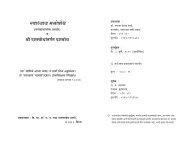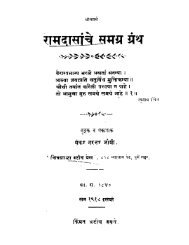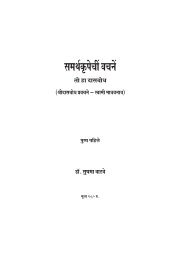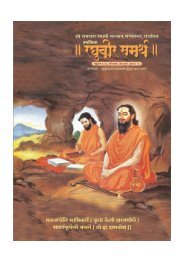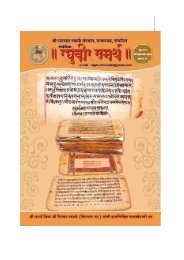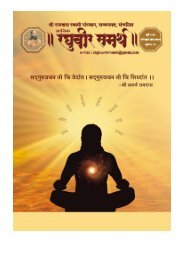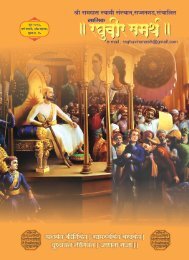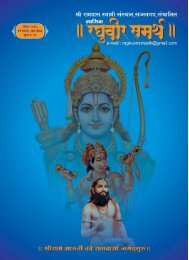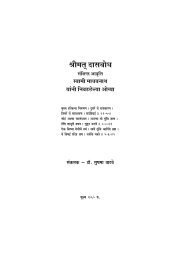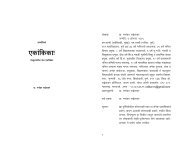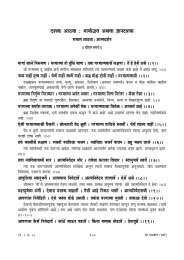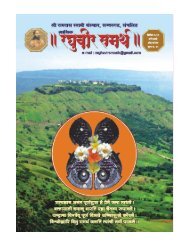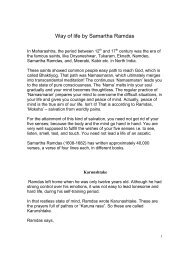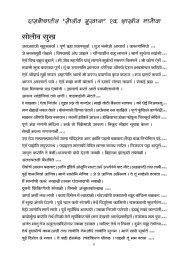THE DASBODHA BY: SADGURU SHREE SAMARTH RAMDAS ...
THE DASBODHA BY: SADGURU SHREE SAMARTH RAMDAS ...
THE DASBODHA BY: SADGURU SHREE SAMARTH RAMDAS ...
Create successful ePaper yourself
Turn your PDF publications into a flip-book with our unique Google optimized e-Paper software.
podium during his marriage ceremony he heard the Brahmins clattering loudly, “Beware”!<br />
Immediately after hearing it he knew what it meant and just ran away from the scene and went to<br />
the holy city, Nasik, where he started his worship of Lord Ram which lasted for 12 years. He did it<br />
the hard way, many a times remaining without food or water, for days together. Every millisecond<br />
of this time he spent in the worship of Lord Ram. During this time he was constantly guided from<br />
within by greatest worshipper of Lord Ram, Hanuman. After 12 years of extensive Sadhana he got<br />
the blessings of Lord Ram again and through him he also got the real knowledge and then he<br />
embarked on a pilgrimage of most of the holy places of India which he completed in 12 years, bare<br />
feet. After finishing the pilgrimage he went back to Mahabaleshwar. Then at Masur he celebrated<br />
the birth day of Lord Ram wherein thousands of people took part in the religious activities. He<br />
started gathering people around him which was essential for his ultimate goal of establishing the<br />
Hindu religion in its original form which was in a shambles because of hundreds of years of<br />
Muslim rule in the country. Next year he found the statues of Lord Ram in the deep waters of the<br />
river Krishna near Angapur. He built a temple at Chafal and installed them ceremoniously<br />
according to the Hindu tradition. He celebrated the birth day of Lord Ram that year at the newly<br />
built temple.<br />
The only Hindu King of any substance, who spent his whole life<br />
fighting the foreign Muslim rulers, Shree Shivaji Maharaj requested Shree Samarth to accept him<br />
as his disciple and knowing him thoroughly well Shree Samarth immediately consented. Shree<br />
Shivaji Maharaj from this time onwards always took Shree Samarth’s advice in all the important<br />
matters. Then Shree Shivaji Maharaj as a token of respect towards the Guru offered Shree Samarth<br />
his whole kingdom, saying that he will look after it as only a caretaker, but it will belong to Shree<br />
Samarth. Shree Samarth was moved by this gesture and praised Shree Shivaji Maharaj but told him<br />
that anyhow he himself as Parbrahma was the Atman in Shree Shivaji Maharaj and hence this<br />
wasn’t required at all. Instead he asked Shree Shivaji Maharaj to prepare his Empire’s flag in the<br />
most sacred color in Hindu religion, Maroon. If at all any there will be very few parallels to such a<br />
disciple and Guru.<br />
In the meanwhile according to the wishes of Shree Samarth 11<br />
temples of Hanuman had been established and the Head Priests appointed. Shree Samarth then<br />
went to Jamb as his mother passed away. After returning back he went to Karnataka on a religious<br />
upheaval mission. On way to Karnataka he established a Math in Miraj and appointed a woman<br />
disciple, Venabai as the head Priestess. On reaching Tanjavar he was received by Vyankojiraje, the<br />
brother of Shree Shivaji Maharaj, who was the King of Tanjavar. He also told Shree Samarth of his<br />
desire to become his disciple to which Shree Samarth consented. At Tanjavar one of the very<br />
revered religious figures, Pundit Raghunath also became the disciple of Shree Samarth.<br />
After coming back to Sajjangad, Shree Samarth started writing his<br />
epic, “The Dasbodha”. He also established a temple of the Goddess at the Pratap Fort. Shivaji<br />
Maharaj used to visit him frequently for advice and seeing the qualities of this disciple of his, Shree<br />
Samarth told him the crux of the ultimate knowledge which one has to acquire to merge with the<br />
Parbrahma. He then completed the remaining chapters of the Dasbodha. After the death of Shivaji<br />
Maharaj he wrote a letter to the heir to the throne, Sambhaji (Shivaji’s son) which is considered a<br />
milestone by even today’s political scientists. His job of the Hindu religious renaissance done Shree<br />
Samarth left his mortal body and finally united with the Parbrahma ending a life which was so<br />
multifaceted that without his mention almost no field can be considered as complete. He left his<br />
mortal body at Sajjangad at the age of 73 years.



